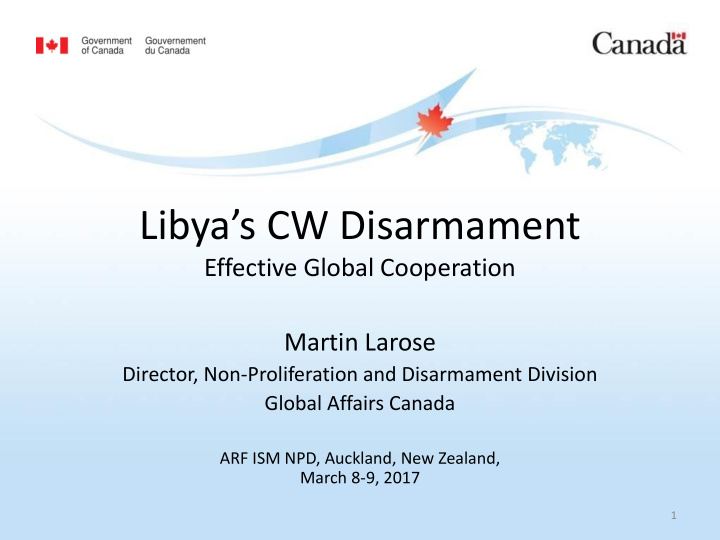



Libya’s CW Disarmament Effective Global Cooperation Martin Larose Director, Non-Proliferation and Disarmament Division Global Affairs Canada ARF ISM NPD, Auckland, New Zealand, March 8-9, 2017 1
Did you know? The first full-scale deployment of deadly chemical warfare agents was during World War I was at the Second Battle of Ypres, on April 22, 1915. The attack targeted Canadian, French and Algerian troops with chlorine gas. 2 St. Julien Canadian Memorial, Saint-Julien, Belgium Photo: Richard Martin-Nielsen
OPCW & CWC • The Organisation for the Prohibition of Chemical Weapons (OPCW) is the implementing body of the Chemical Weapons Convention (CWC), which entered into force in 1997. • As of today OPCW has 192 Member States, who are working together to achieve a world free of chemical weapons. • In 2013, the OPCW won the Nobel Peace Prize for its extensive efforts to eliminate chemical weapons. 3
Libya and Chemical Weapons Background 2004: Libya acceded to the CWC and joined the OPCW. 2010: Operations to destroy the sulfur mustard started. 2011: The National Transition Council informed the OPCW of undeclared CW. 4
Key Factors in Canada’s Assistance 1. The threat 2. Libya’s commitment 3. Libya’s assistance request 4. Canadian WMD non-proliferation mechanisms 5. Protecting Canadian interests 5
Kick-starting the Global Effort • In 2012, Canada contributed CAD $6M to the OPCW to eliminate Libya’s bulk sulphur mustard chemical stockpile. • Canada (via it’s WMD Threat Reduction Program) was able to transfer the funding quickly for this international effort. • Canada’s initial contribution to this global effort was soon augmented by support from Denmark, France, Finland, Germany, Italy, Malta, Spain, UK, USA. 6
WMD Threat Reduction Program (formerly Global Partnership Program) Location: Global Affairs Canada Purpose: to support international efforts to combat and reduce the threat of chemical, biological, radiological and nuclear (CBRN) proliferation and terrorism, through concrete programming and implementing UNSCR 1540. 7
Libya’s CW destruction (1) • Libya’s stockpile of Category 1 CW (bulk and weaponized sulfur mustard) was completely eliminated by May 2014. • The remaining precursor chemicals were stored in precarious conditions in close proximity to ISIL forces • In February 2016, Libya requested the OPCW’s assistance in removing the remaining CW (Category 2) precursors. • In July 2016, the OPCW called on State Parties to consider providing assistance in acquiring and transporting these chemicals for the purpose of CW destruction outside Libya. 8
Libya’s CW destruction (2) • The threat prompted the international community to act quickly • The remaining chemicals were transferred into new containers and removed from Libya for destruction Photo credit: Defence Command Denmark 9
Further Canadian Support • Responding to the OPCW’s call to States Parties for further assistance, Canada contributed an additional € 500,000 to the OPCW towards destroying the remaining Category 2 Ms. Sabine Nölke Ambassador of Canada to the Kingdom of the Netherlands CW in Libya. Permanent Representative of Canada to the Organization for the Prohibition of Chemical Weapons 10
Wrap Up To date, Canada has contributed $6.7M to the OPCW for CW destruction in Libya. Key accomplishments include: – 24 metric tonnes of Category 1 chemical agent (sulfur mustard) stored in bulk containers – 496,305 metric tonnes of Category 2 chemical agent were decanted from deteriorating leaking tanks into new tanks, safe for storage and transport; and – Provided support for training and for related equipment such as a sea worthy containers for transport, GPS tracking system of almost 500 metric tonnes of Category 2 chemical agent from the territory of Libya for its destruction. 11
QUESTIONS? Martin Larose Director Non-Proliferation and Disarmament Division (IGN) Global Affairs Canada Email : martin.larose@international.gc.ca
Recommend
More recommend